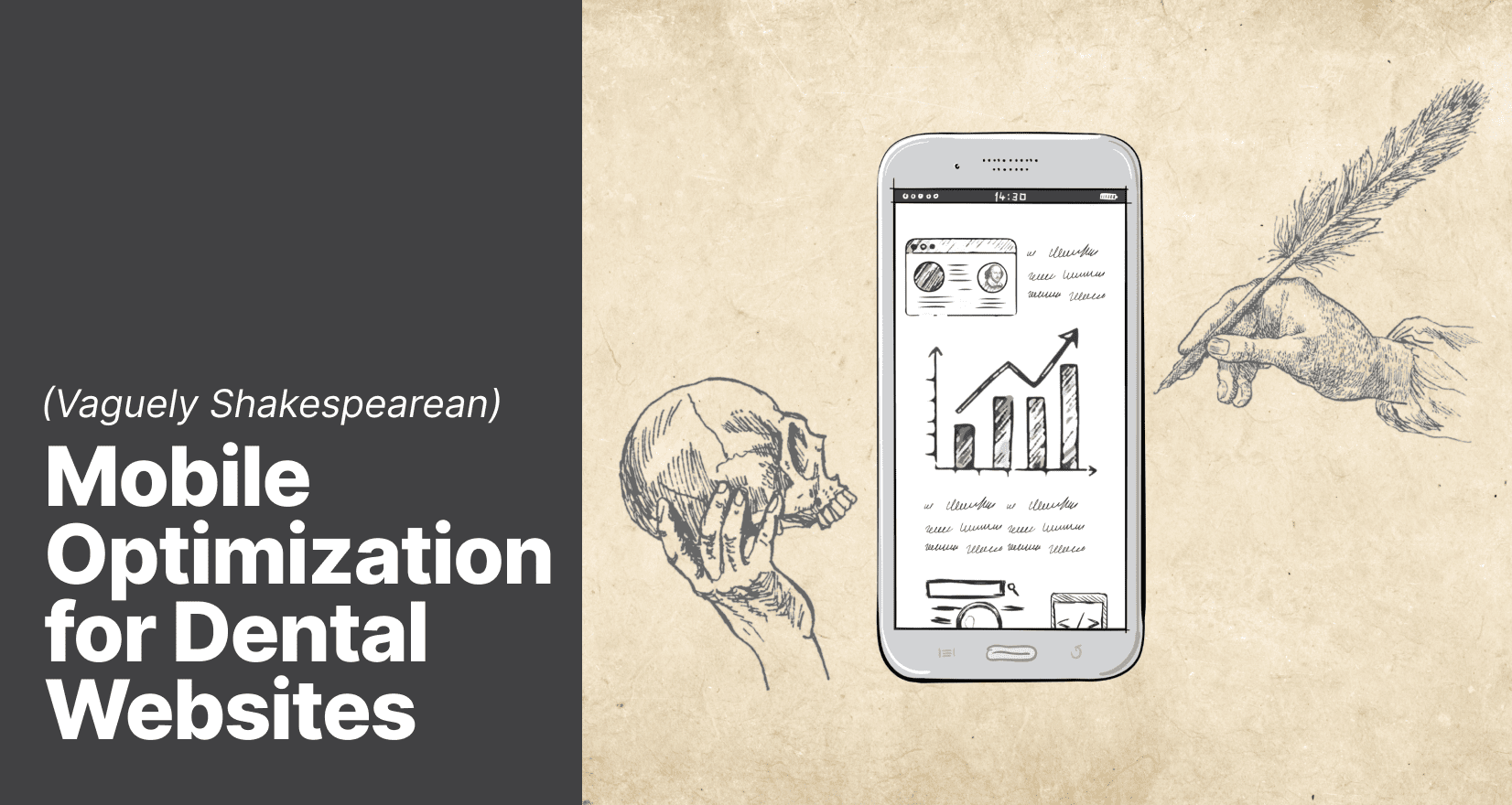
Friends, Dentists, Countrymen, Lend Me Your Ears as I Talk About Mobile Optimization for Dental Websites
Once upon a time, people used to sit at a desktop computer when connecting to Ye Olde Internet. Back when Shakespeare was writing about mentally precarious royalty, impulsively suicidal teenagers and like, fairies and stuff, he and his esteemed literary fellows had to fire up the old dial-up modem to Ask Jeeves for a local dentist or the nearest pantaloons store. (On an unrelated note, I did not study history in college.)
Despite the undeniably appealing aesthetic of the image, your patients aren’t sitting at a desktop computer searching for a dentist while sipping tea in a mahogany-paneled study. They probably don’t even have a fancy feathered hat. They’re on their phones, usually juggling kids, errands, or a half-finished latte…or they’re on the toilet. Don’t give me that look, you know it’s true.
That means if your dental website isn’t designed to shine on a smartphone, you’re probably losing patients before they even see how great your practice is, regardless of how appealing your homepage is to modern audiences or Elizabethan-era playwrights.
Google now prioritizes mobile versions of websites when deciding who shows up in search results. It’s called mobile-first indexing—and for dentists, it’s a game-changer as major as Wifi.
Man, Shakespeare would have loved Wifi.
Anyways, a website that isn’t mobile-optimized can look outdated, load slowly, or be downright unusable on a phone. And in today’s modern world of cool blue jeans rather than poofy breeches, that’s like having a “Closed” sign hanging on your digital front door.
The good news? Mobile optimization isn’t nearly as complex as King Lear, and when done right it can boost your visibility online, improve patient trust, and make booking an appointment as easy as Googling the themes of Hamlet to understand what that guy’s problem was.
The Table Upon Which Contents Art Found
- Alas, What Is Mobile-First Indexing?
- How Doth One Structure a Dental Website for Mobile?
- Most Excellent Customs: Mobile SEO Best Practices for Dental Websites
- Mobile Optimization and the Future of AI Search for Dentists According to Expert Soothsayers
- Why Doth the Optimization of Mobile Devices Bear Import to a Dental Practice?
- Fleet-Footed Counsel for the Mobile Optimization of Dental Websites
- To Thine Own Mobile Optimization Strategy Be True
- FAQ
Alas, What Is Mobile-First Indexing?
Google used to crawl and rank websites based on their desktop versions. But nobody’s looking up “dentist near me” on a Windows 98 desktop anymore. People search on their phones, and Google knows it. That’s why they switched to mobile-first indexing.
Here’s what that means in plain English: Google now looks at your mobile website first when deciding where you show up in search results. If your mobile site is slow, hard to read, or missing content, Google doesn’t shrug it off and say, “Well, their desktop site is fine and written in perfect iambic pentameter.” Nope. It just assumes your whole site is bad, and your rankings take the hit. Rude.
For dental practices, this is especially important. Patients searching for “emergency dentist,” “teeth whitening near me,” or even just your practice name are likely doing it on a smartphone. If your website doesn’t deliver a smooth mobile experience, those patients won’t stick around. After all, more than 63% of all Google search traffic comes from mobile devices. And worse, a patient who gets frustrated with your website might call the other dentist down the street whose site does work well on mobile, even if their prose is garbage.
How Doth One Structure a Dental Website for Mobile?
There are a few different ways to build a mobile website, but only one really makes sense for dentists: responsive design.
Responsive design is like the dental equivalent of a good Shakespearean insult; it adapts to whatever it needs to fit. Whether your patient is on the newest iPhone, an old Android, or a tablet, your site automatically adjusts to the screen size. No squinting, no sideways scrolling, no frustration. Just a clean, professional experience that makes your practice look trustworthy.
What about those “m-dot” websites (you know, m.yourdentalsite.com) that were popular in the early 2010s? Forget about them. They’re outdated, harder to maintain, and usually cause SEO headaches because you’re basically running two sites at once. Same goes for complex setups that serve different versions of your site depending on the device—too much room for technical issues. You want a dental website, not a comedy of errors. (Get it?)
If you want Google (and patients) to love your website, stick with responsive design. It’s simpler, smarter, and the best long-term investment for your practice’s online presence.
Most Excellent Customs: Mobile SEO Best Practices for Dental Websites
Okay, so you know mobile optimization matters. But what does that actually look like for your dental website? Here are a few best practices to make sure your site is so pretty, a teenager wearing tights will show up at your balcony in the middle of the night wishing he were a glove.
1. Test Your Website’s Mobile Friendliness
Don’t guess—test. Tools like Google’s Lighthouse or PageSpeed Insights will quickly tell you if your fonts are too small, your buttons are squished together, or your images take forever to load.
2. Keep Your Site Crawlable and Structured
Search engines (and AI systems, more on that later) need to “read” your website. Make sure you’re not blocking important files like CSS or JavaScript that help Google understand your site’s layout. Bonus points for using structured data. These little bits of code tell Google things like your office hours, reviews, and location. Structured data makes your practice info easier to find and more likely to show up in search features.
3. Prioritize Speed
On mobile, slow equals gone. Most people will bounce if your site takes longer than a few seconds to load. Optimize images, trim unnecessary scripts, and enable caching. Site speed is like patient wait times: fast = happy customers, slow = disgruntled iPad kids in the waiting room asking if they can play Minecraft on your receptionist’s phone.
4. Design for Real People, Not Robots
Yes, SEO is important, but your patients are the ones using your website, not Google. Make sure your calls-to-action (like “Book Appointment” or “Call Now”) are obvious and easy to tap. Navigation should be simple, text should be easy to read, and nobody should need a magnifying glass to find your phone number.
Mobile Optimization and the Future of AI Search for Dentists According to Expert Soothsayers
Just when you thought keeping up with Google’s algorithms was enough of a task, along comes AI-powered search. Tools like Google’s AI Overviews and Bing’s Copilot are starting to answer people’s questions directly in search results, sometimes before they even see the regular list of websites.
So where does your dental practice fit into this brave new world? That’s where Generative Engine Optimization (GEO) comes in. GEO is all about making your website more likely to be pulled into those AI-generated answers.
If your website isn’t mobile-optimized, your chances of showing up in AI results drop dramatically. Why? Because AI tools lean on the same things Google does when analyzing a website: fast-loading, mobile-first, well-structured content. Go figure.
How This Helps Dentists in Real Life…eth.
It’s hard to title these sections sometimes. Anyway.
- Got an FAQ page? It probably answers important questions like, “Do you take new patients?” or “What insurance do you accept?” or “Did Shakespeare have false teeth or was that George Washington?” A mobile-friendly layout makes it easier for AI to grab and quote that answer in an overview.
- Have an online appointment form? If it works smoothly on mobile, there’s a better chance patients see it highlighted when they search “dentist near me open now.”
- Keep your location, phone, and hours consistent across your site? That structured, mobile-ready info is exactly what AI wants to show people.
AI search is growing fast, and being featured in an AI Overview could send a steady stream of patients your way. But the doorway into that future is the same as it is today. Surprise, it’s a fast, mobile-optimized dental website.
Why Doth the Optimization of Mobile Devices Bear Import to a Dental Practice?
So why put all this effort into mobile optimization? Simple: it directly affects your bottom line.
More Visibility in Search and AI Results
When your website is mobile-friendly, Google and AI tools are more likely to showcase your practice. That means more potential patients finding you first when they search for “dentist near me” or “emergency toothache help.”
Better Patient Experience
Think about it: if a patient can easily read about your services, tap your phone number, or schedule an appointment—all from their phone—they’re more likely to follow through. A smooth mobile experience builds trust before a patient ever steps foot in your office.
Competitive Advantage
If the dental office across town still has a clunky, slow site from 2012, you’ve already won. Patients (and Google) notice the difference. A modern, mobile-optimized website makes your practice look current, trustworthy, and ready to help.
In short, mobile optimization isn’t just about making Google happy. It’s about making life easier for your patients so that they don’t find themselves monologuing at a skull about whether or not to call your office.
Fleet-Footed Counsel for the Mobile Optimization of Dental Websites
Want the fast version? Here’s a quick-hit list to make sure your dental website is pulling its weight on mobile written in convenient Shakespearean prose. Are they historically accurate? Do they make grammatical sense? You’re probably a dentist, not a literary historian, so I’m going to say absolutely they are.

✅ Use responsive design – One site that works on every screen, no headaches.
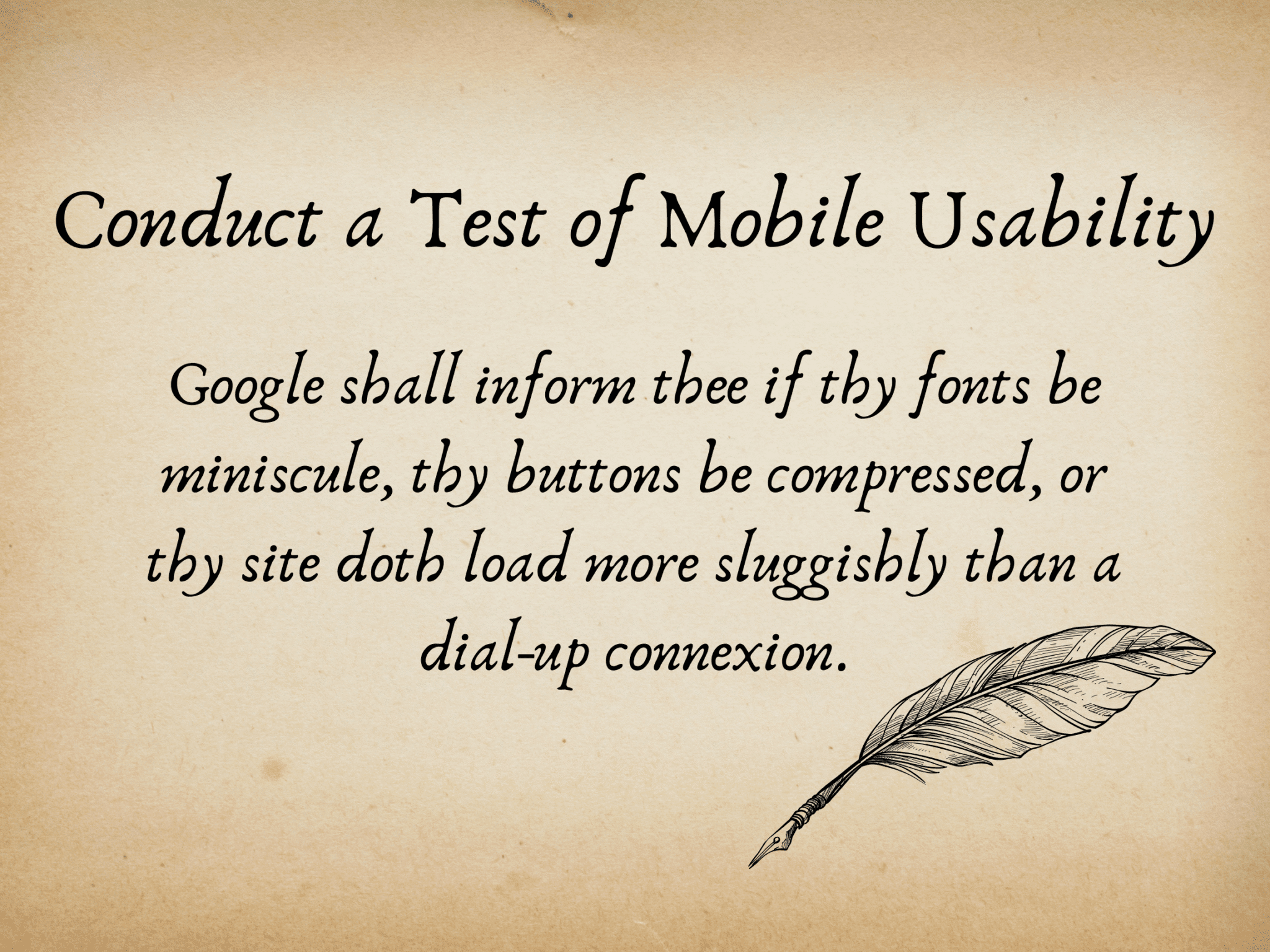
✅ Run a mobile usability test – Google will tell you if your fonts are tiny, your buttons are squished, or your site loads slower than a dial-up connection.
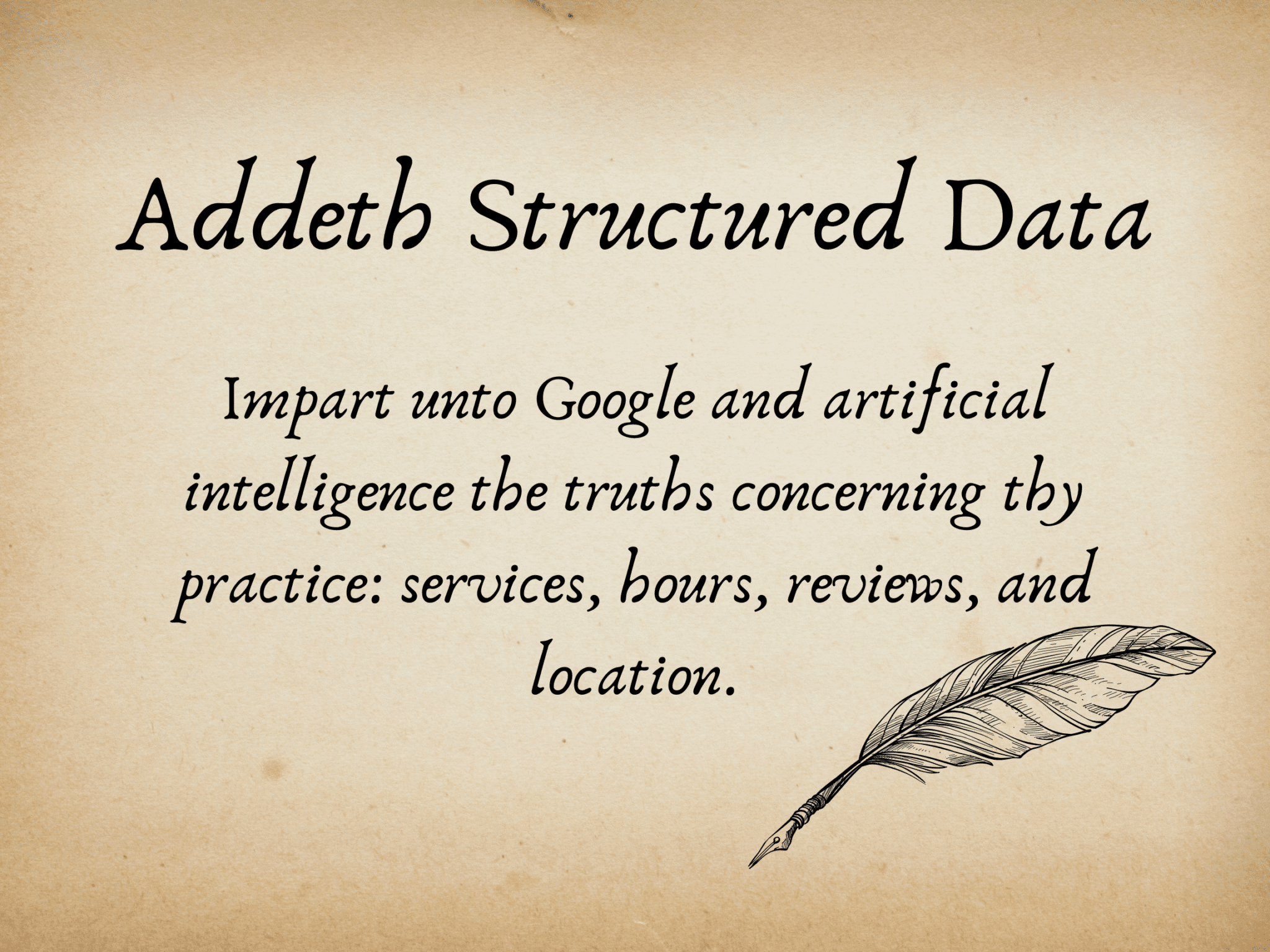
✅ Add structured data – Give Google and AI the facts about your practice: services, hours, reviews, and location.

✅ Compress images and speed things up – Every second counts. Faster sites = happier patients.
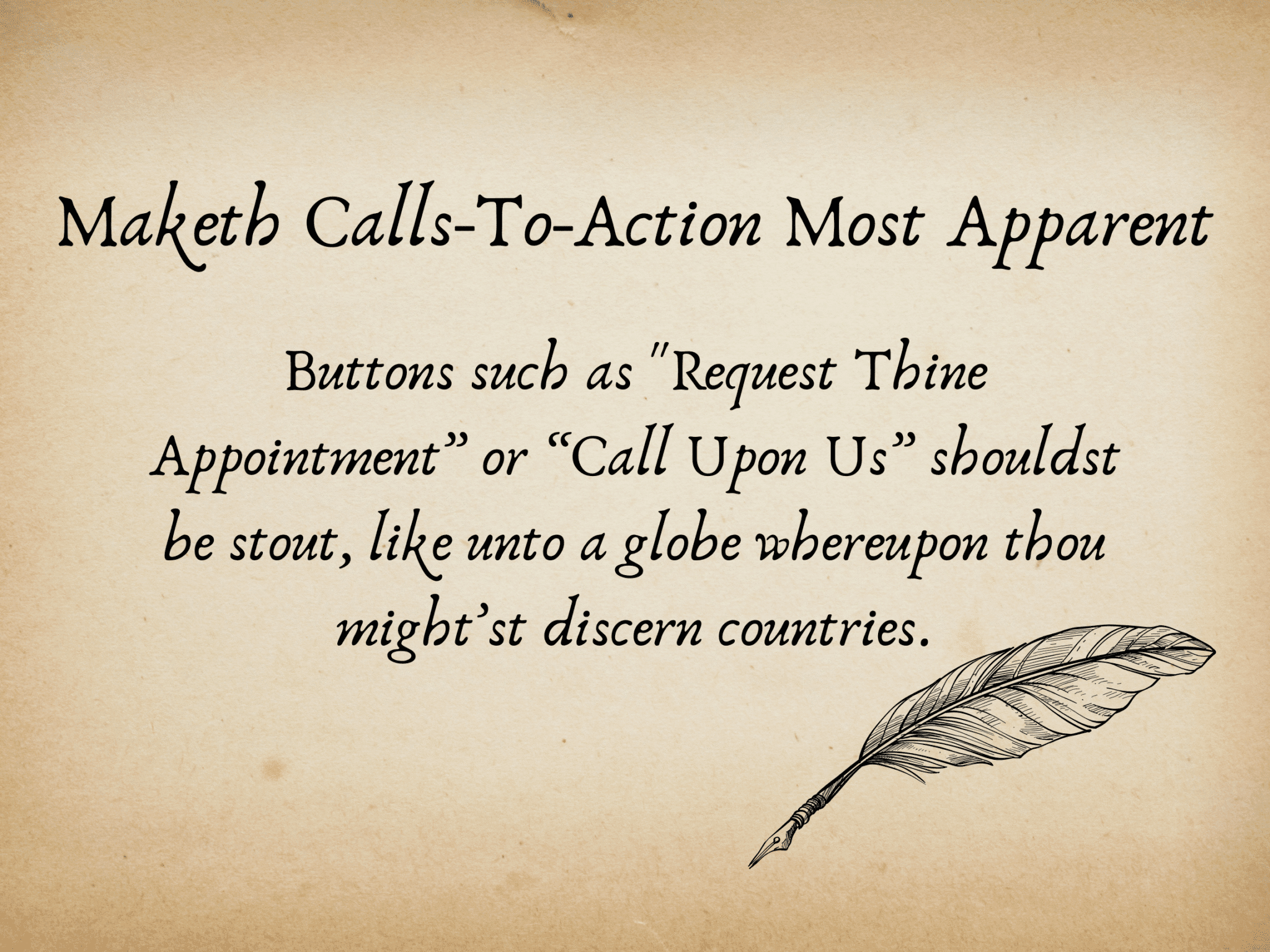
✅ Make calls-to-action obvious – Buttons like “Request an Appointment” or “Call Today” should be big, bold, and impossible to miss.

✅ Build GEO-friendly content – A simple FAQ page and clear service descriptions help your practice appear in AI-powered results.
To Thine Own Mobile Optimization Strategy Be True
At the end of the day, mobile optimization for dental websites is a critical component of SEO. Patients are searching for you on their phones, Google is ranking you based on your mobile site, and AI-powered search engines are pulling answers from mobile-friendly content. If your site isn’t optimized, you’re basically telling potential patients, “Away, you moldy rogue, away!”
Fortunately, fixing it doesn’t have to be complicated. With the right strategy, you can have a beautiful, responsive dental website that loads quickly, works flawlessly on every device, and gives you a competitive edge in search results (and AI results, too).
That’s exactly what we do at My Social Practice. Our team builds mobile-optimized dental websites that aren’t just Google-friendly—they’re patient-friendly. From clean design to SEO to future-proofing your site for AI search, we make sure your digital front door is wide open for new patients. We’re dedicated to helping you navigate the quickly evolving world of digital marketing so you feel confident that you’ll always be a step ahead.
As The Bard once famously said, “It is not in the Google SERPs to hold our destiny but in ourselves and our dental marketing strategies.”
(Don’t Google that.)
Frequently Asked Questions
Why is mobile optimization important for dental websites?
Mobile optimization makes your dental website easy to use on smartphones and tablets—the devices most patients rely on to find a dentist. A mobile-friendly site improves Google rankings, patient trust, and a
How does mobile optimization affect SEO for dentists?
Google uses mobile-first indexing, which means it ranks your practice based on your mobile site. If your mobile site loads slowly, is hard to navigate, or lacks content, your SEO will suffer. A responsive, mobile-optimized site ensures your practice shows up higher in search results.
Can mobile optimization help my dental website appear in AI search results like Google Overviews?
Yes! AI-powered search tools rely on fast, mobile-friendly sites to provide answers. A well-structured, mobile-optimized dental website increases your chances of being featured in AI results—making it easier for patients to find your services, location, and contact info quickly.
About the Author: Megan Nielsen is an SEO strategist and the Grand Overlord of copywriting at My Social Practice. My Social Practice is a dental marketing company that offers a full suite of dental marketing services to thousands of dental practices throughout the United States and Canada.
![[Byte Sized Podcast Ep. 23] Frictionless Online Dental Scheduling: Why Your Practice Needs It Now Feat. Colin Ambler - mobile optimization for dental websites - My Social Practice - Social Media Marketing for Dental & Dental Specialty Practices online dental scheduling](https://mysocialpractice.com/wp-content/uploads/2025/12/byte-sized_ep23.png)
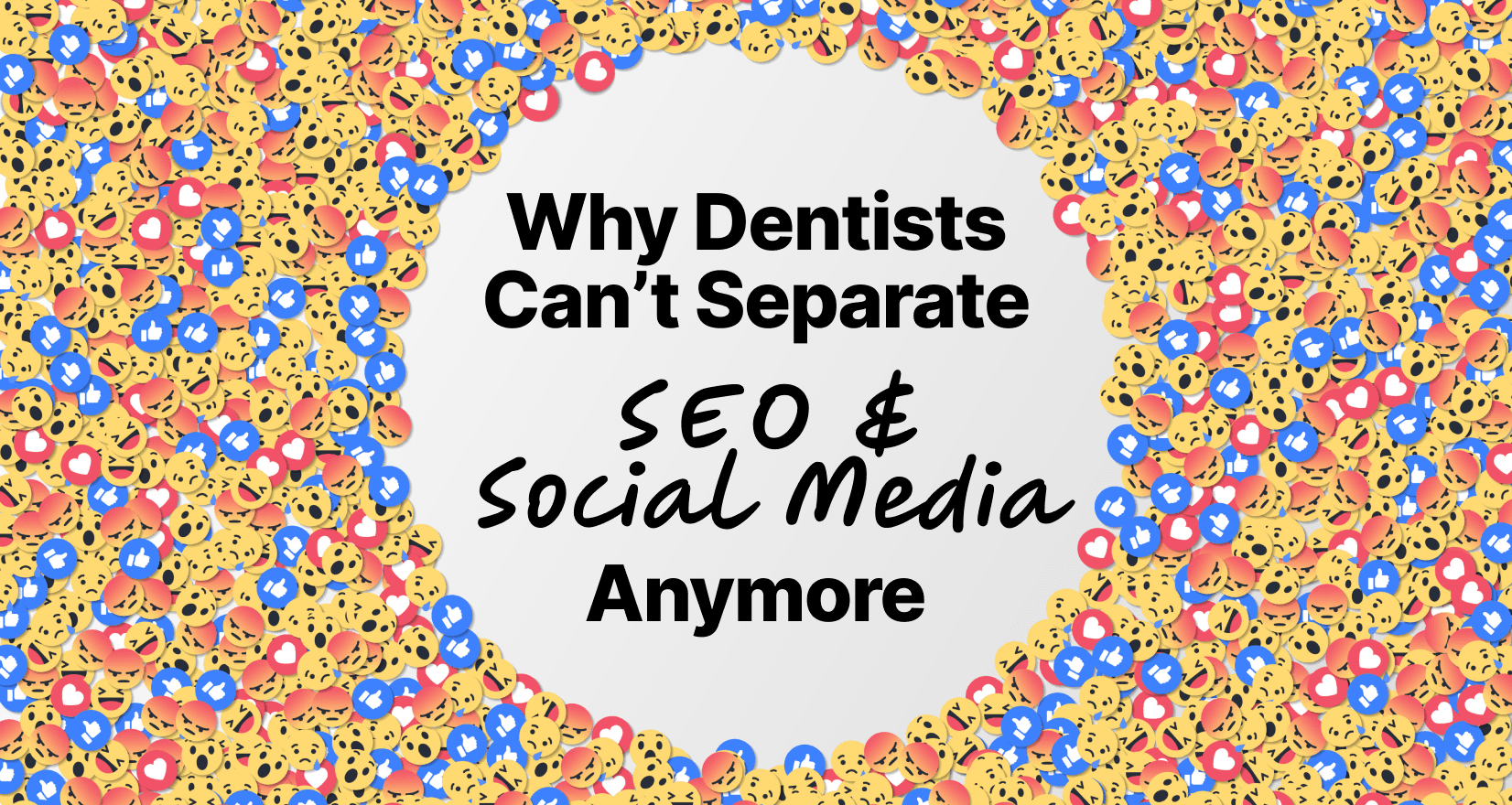



![[Byte Sized Podcast Ep. 23] Frictionless Online Dental Scheduling: Why Your Practice Needs It Now Feat. Colin Ambler - mobile optimization for dental websites - My Social Practice - Social Media Marketing for Dental & Dental Specialty Practices online dental scheduling](https://mysocialpractice.com/wp-content/uploads/2025/12/byte-sized_ep23-100x100.png)



